In the Arctic cloud cover is extensive at all times of the year, with monthly means ranging from 50-80%. Retrievals of the clear sky surface temperature are therefore of limited utility for climate studies. Is it possible to estimate the surface temperature under cloud cover from thermal satellite data? Previous studies have used nighttime data to examine the relationship between clouds and surface temperature. Here a thermodynamic model is used to extend the analyses to daytime conditions. The thermodynamic model includes radiative transfer, sea ice/snow energy balance, and atmospheric turbulence components.
The figure below shows the modeled surface temperature of sea ice over time, for transitions from cloudy to clear and back to cloudy. Results are given for a variety of wind speeds and for fixed cloud and surface properties.
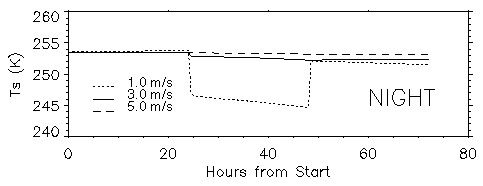
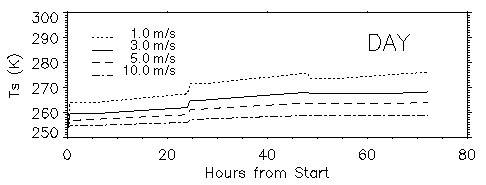
Nighttime surface temperature differs by as much as 8 degrees during the transitional period with a wind speed of 1 m/s. Under such calm conditions, radiational cooling most strongly affects surface temperature under clear skies. Higher wind speeds influence turbulent mixing and sensible heat flux toward the surface, as seen by the higher temperatures even under clear conditions. These results confirm observations that turbulence transfers heat more effectively than radiation, and that the snow surface temperature and near-surface air temperature are so closely coupled that they adjust quickly to each other via turbulent fluxes.
At solar zenith angle of 50 degrees and a 1 m/s wind speed, surface temperature rises by 4 K during the transition from overcast to clear conditions, and drops by 2 K at the subsequent overcast period before resuming the warming trend. Overall surface temperatures are highest for low wind speeds as heat is not removed from the surface as readily through turbulent transfer. The initial surface temperature is 275 K for the calmest condition, while at 10 m s-1 the surface temperature is only 257 K, an 18 degree difference. Under stronger winds, temperature rises only 1 K at the overcast-clear transition, and decline only a fraction of a degree when overcast conditions resume. As wind speeds increase, the positive slopes for surface temperature throughout the 24-hour day periods become less steep, indicating that stronger winds transfer heat more effectively from the surface.
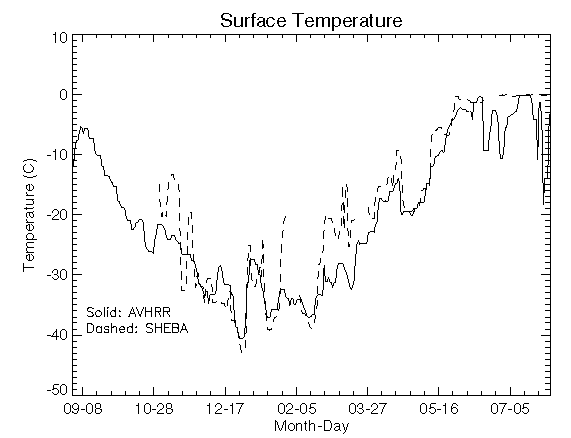
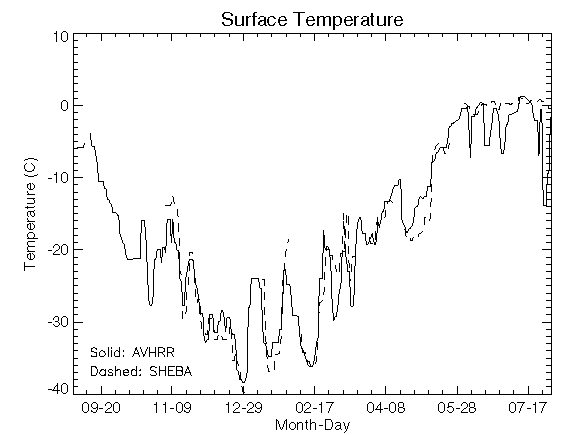
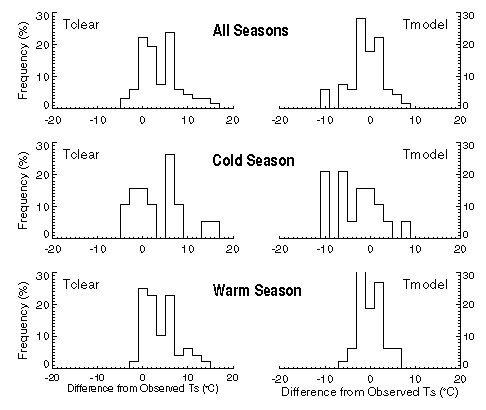
Key, J., 2000. The Cloud and Surface Parameter Retrieval (CASPR) System for Polar AVHRR Data User's Guide. Space Science and Engineering Center, University of Wisconsin, Madison, WI, 62 pp.
Wong, A.M. and J. Key, 2000. Estimating the cloudy sky surface temperature of sea ice from space, J. Geophys. Res., submitted (April 2000).
Key, J., J. Collins, C. Fowler, and R. Stone, 1997. High-latitude surface temperature estimates from thermal satellite data. Remote Sensing Environ., 61, 302-309.
Key, J. and M. Haefliger, 1992. Arctic ice surface temperature retrieval from AVHRR thermal channels. J. Geophys. Res., 97(D5), 5885-5893.